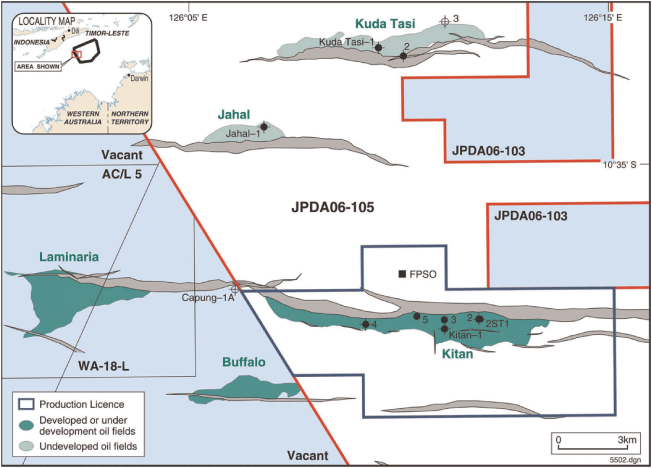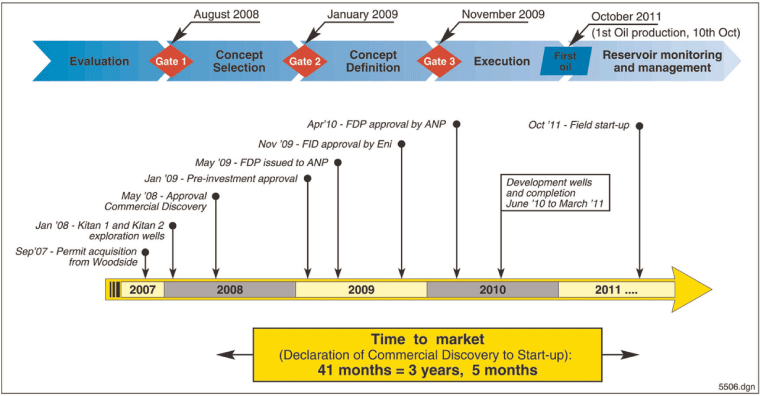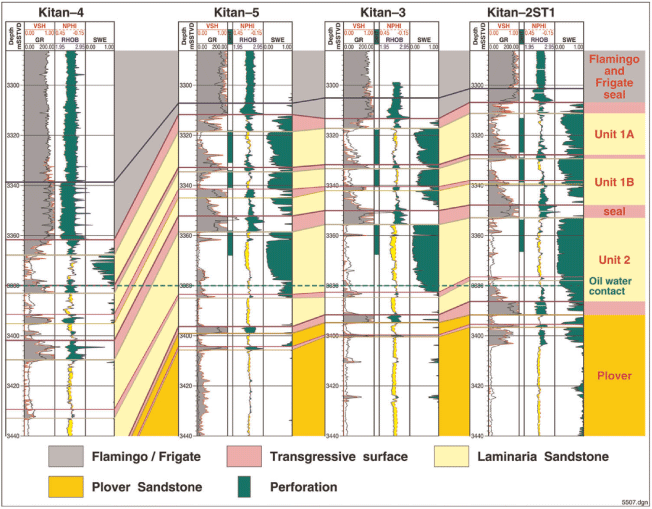Discovery to development: a subsurface case history of the Kitan Oil Field, Timor Sea, Joint Petroleum Development Area, Timor-Leste and Australia
Dave Wheller A , Grant Ellis A , Yohan Suhardiman A , Ryosuke Yokote A , Doani Selvaggi B , Giuseppe Maniscalco A and Joseph Derrij AA Eni Australia Ltd.
B Eni Indonesia.
The APPEA Journal 53(2) 439-439 https://doi.org/10.1071/AJ12050
Published: 2013
Abstract
The Kitan Oil Field is located in the northern Bonaparte Basin in the Joint Petroleum Development Area, an area jointly administered by Timor-Leste and Australia. The Kitan structure is a Jurassic east-west trending tilted fault block.
The Kitan-1 exploration well was drilled and successfully tested in early 2008. Kitan-2 appraisal well was drilled immediately after Kitan-1 and intersected the reservoir up-dip from Kitan-1 and confirmed the extension of the oil accumulation.
The main oil-bearing section is in the shallow marine sandstone of the Middle Jurassic Laminaria Formation. It is divided into two reservoir zones: a blocky channelised sandstone (Unit-2) overlain by a dominantly finer-grained succession composed of coarsening-upwards para-sequences (Unit-1).
Kitan oil field was declared a commercial discovery in April 2008 and a field development plan was submitted in May 2009 and approved in April 2010. Four development wells were drilled of which three were completed as producers, each employing an intelligent completion design to enable independent control and monitoring of the two reservoirunits. The three wells were tied back subsea via flexible flowlines and risers to the Glas Dowr FPSO.
Oil production from the Kitan started in October 2011, about 3.5 years after the discovery of the field. The fast-track development of Kitan was achieved due to accelerated appraisal, prompt completion of studies, early commitment to long lead items, and excellent support from joint-venture partners and government.
Introduction
Between 1990 and 2009, the mean time from field discovery to first hydrocarbon production in the greater Asia Pacific was nine years (Shuqiang, 2010). In this regard, the Kitan Oil Field development has been a successful endeavour for Eni and partners, with the fast tracking from discovery to production in 3.5 years being one of the project highlights.
The Kitan Oil Field is located in the northern Bonaparte Basin in the Timor Sea in the Joint Petroleum Development Area (JPDA) 06-105 Production Sharing Contract (PSC) (Fig. 1).
Kitan discovery and appraisal
After acquiring an interest in the PSC, Eni immediately reinterpreted the Kitan prospect using a pre-stack depth migration (PSDM) reprocessed cube from the Ikan 3D seismic survey. Subsequent volumetric, risk, and economic analysis highlighted the potential in the Kitan prospect and resulted in the joint-venture partners (JVP) approving the drilling of Kitan-1.
Kitan-1 was spudded on 8 January 2008 to test a three-way dip-closed and tilted-fault block. The well intersected gross and net oil columns of 48 m and 27 m respectively in the Jurassic Laminaria Formation with an oil-water contact (OWC) at 3,380 m subsea (mSS). A drill-stem test was performed and the well flowed at a rate of up to 6,100 barrel oil per day (bopd) of under-saturated 59.5° API oil in a 95/8″ production liner on a 32/64" choke. Kitan-1 was plugged and suspended.
Following the success at Kitan-1, a decision was made to appraise the Kitan discovery without delay and Kitan-2 was spudded on 4 March 2008. Kitan-2 is located 1.5 km east from Kitan-1 and up dip and closer to the northerly-bounding fault. Kitan-2 confirmed gross and net oil columns of 72 and 55.2 m respectively in the Laminaria Formation with the same OWC and pressure regime as Kitan-1 (OWC 3,380 mSS).
The results from the back-to-back drilled exploration and appraisal wells successfully demonstrated good reservoir correlation, the same oil type, the same OWC, strong evidence of oil-to-oil continuity, and a highly productive reservoir. The JVP were satisfied that sufficient quality data had been acquired to justify submitting a declaration of commercial discovery only three months after spudding the first well.
The JPDA 06-105 Joint Venture duly submitted a declaration of commerciality and proposed development area for Kitan on 11 April 2008 to the governing body of the JPDA in Timor Leste, the Autoridade Nacional do Petroleo (ANP). The development area was approved on 19 May 2008, which automatically established a maximum 12-month window for submission of the field development plan (FDP), in accordance with the PSC terms.
Kitan concept selection and definition
With the successful exploration and appraisal results in hand and the development area approved, together with the assurance provided by several analogous commercially successful oil fields in close proximity, the JVP had the confidence to implement a plan to fast track the development of the Kitan Oil Field.
The concept selection phase was started in August 2008. After several sensitivity runs and studies, the concept selection phase was concluded with the preferred development strategy for the Kitan Oil Field consisting of three vertical producer wells with intelligent completion and gas lift. A reference development case was generated and the concept definition phase commenced in January 2009.
With the short deadline for FDP submittal, the subsurface modelling focus was given to the factor identified as having the greatest uncertainty and biggest influence on field volumetrics—specifically that of accurate depth mapping. Three structure maps—low, base, and high—were generated based upon optimistic and pessimistic seismic interpretation; they were also used as input for static and dynamic modelling and production forecasting. Low, base, and high case reserve estimates were reported in the FDP and used for planning. Importantly the low case reserves still indicated a good commercial result and gave confidence to submit the FDP for approval and move to execution phase.
It took more than two years from discovery to obtain FDP approval. The project could now move from concept select and definition to the execution phase, starting with the development drilling.
A summary time-frame of the Kitan project with key dates is shown in Fig. 2.
Kitan execution phase: development well drilling
Development drilling commenced in June 2010. Four development wells were drilled, three ready for completion, and one plugged and temporarily suspended. The rig stayed on location to perform the batch completions and clean up flow tests, leaving the production wells ready to be tied back to the floating, production, storage, and offloading (FPSO) facilities, which arrived on location in July 2011.
Kitan reservoir architecture
The Plover and Laminaria para-sequences can be correlated across the Kitan Field (Fig. 3). The importance of the stratigraphy was considered with the well and completion design. Laminaria Unit-2 demonstrated better reservoir quality than Unit-1 and, thus, has better predicted production performance. Perhaps more importantly, the flooding surfaces may act as baffles or barriers to fluid flow. Perforation was required in each zone to ensure effective sweep of the entire sequence. The most significant event within the Laminaria Formation is the 5–8 m claystone and siltstone that separates Laminaria Unit-1 and Unit-2, this event can be correlated region wide and is probably a more noteworthy flooding episode. This layer was assumed in the geological reservoir model to act as a production barrier and sealing in a production time frame.
Kitan production and intelligent completion
The Glas Dowr FPSO, owned and managed by Bluewater Ltd., arrived on location in July 2011 for commissioning after modifications in Singapore. Installation of flowlines, risers, and umbilicals between the wells and the FPSO began in September and, following final commissioning activities, first oil production was achieved on the 10 October 2011. The Glas Dowr FPSO has a crude storage tank capacity of 674,800 bbls, with total liquid production capacity of 50,000 bpd, oil production capacity of 40,000 bpd, and water-production handling capacity of 35,000 bpd.
The Kitan completion is an intelligent design incorporating 5.5" tubing and gas lift, allowing each of the main reservoir zones to be produced individually or co-mingled. A strong aquifer support is observed in the nearby fields. Intelligent completion design was adopted to reduce and manage the water production coming from the two Laminaria Units (Unit-1 and Unit-2) by controlling the different downhole flow control valves (Yokote et al, 2012).
Collectively, the Kitan Oil Field maintained an oil production plateau for about nine months from October 2011 to June 2012. This was six months longer than pre-production base case-modelling expectations. It was for this reason the geological and dynamic model were revisited with a different depth conversion technique used for the reservoir structure map.
Kitan-5 was the first well to have water production breakthrough in early December 2011. In April 2012, Kitan-5 lower FCV was closed and water production stopped from this well. Kitan-3 and Kitan-2ST1 water break through occurred in late February 2012 and August 2012, respectively.
Conclusion
Oil production from the Kitan Oil Field started in October 2011, about 3.5 years after discovery. The Kitan development project, although analogous to nearby fields, was technically challenging, particularly given the relatively short time frame of execution. The main factors that have led to this development project being suitable for fast tracking were:
-
excellent exploration and appraisal results and data acquisition;
-
relatively small oil field;
-
close proximity to proven successful and analogous oil fields;
-
prompt completion of studies;
-
pre-production low case recovery estimates being economic, enabling long-leads items to be purchased before the final investment decision (FID);
-
PSC terms and conditions;
-
technically and commercially aligned JVP; and,
-
supportive external stakeholders, in particular the ANP.
The observed differences in geology and productivity of Laminaria Unit-1 and Unit-2 have been considered by developing the field with vertical wells and using intelligent completion to allow downhole flow control in the two units.
Acknowledgements
The authors thank Eni Australia Ltd and JVP Inpex Timor Sea Ltd and Talisman Resources (JPDA 06-15) Pty Ltd for permission to publish this paper. Thanks and appreciation is conferred to the ANP for their support and dedication to the Kitan project. Gratitude is also extended to Adrian Goldberg, Tony Dixon, Anelia Simeonva, Dave Hearty, Fiona Burns, Carl Stark, Konstantin Galybin, and Shane McGilligan. Finally appreciation is given to the contribution made by past team members (who worked on the project) of Eni Perth sub-surface team: Kon Kostas, Glenn Simon, Andrea Caudullo, Paola Giaj-Via, Enrico Salardi, Aaron Bond, and Vanni Donagemma.
References
Shuqiang, F., 2010—Upstream oil and gas project development timing. International Oil and Gas Conference and Exhibition, Beijing, China, 8–10 June, SPE 130008.Yokote, R., Milne, J., Sanasi, C., Hosatte, P., Mukashev, N., and Nishant, C., 2012—Intelligent well completion in the Kitan Oil Field. SPE Asia Pacific Oil and Gas Conference and Exhibition, Perth, Australia, 22–24 October, SPE 158463.

Dave Wheller graduated from the University of Southampton in 1991 with a bachelor’s degree (geology) and from the University of Reading in 1992 with a master’s degree (sedimentology). From 1992 to 1997, he worked for PGS Reservoir Consultants. He joined Anadarko Algeria Corporation in 1997 and spent the following eight years located in London and Algeria working in asset teams developing onshore oil and gas fields. In 2005, he joined Eni Australia Ltd as a senior geologist specialising in reservoir characterisation, geological modelling, and subsurface project development. |

Grant Ellis graduated from the University of South Australia in 1971 with a BAppSc and in 1973 with a graduate diploma (economic geology). He spent 1972 as a well site geologist with Core Laboratories. From 1974 to 1978, he worked in sedimentary uranium exploration with Mines Administration. In 1978, he joined Marathon Petroleum Australia where he spent the next 16 years, initially in uranium and base metal exploration, and subsequently in oil exploration and development. With the closure of Marathon’s Perth office, he worked as a consultant before joining Hardy Petroleum in 1997. He is now Timor Sea exploration project leader and geological coordinator with Eni Australia Limited. |

Yohan Suhardiman graduated from the French Institute of Petroleum (Institut Francais du Petrole School) in 2003 with an MSc (reservoir engineering). In 2003, he joined Total Indonesia as a reservoir engineer working on simulation study for Handil oil field. In 2006, he joined Eni Indonesia where he performed an integrated reservoir study for Bangka, Jau, and Gehem gas fields. In 2009, he was assigned to ENI HQ in Milan working for reservoir study department covering Russia, Indonesia, Australia, India, and Turkmenistan fields. In 2011, he was posted to Eni Australia in Perth, where he is now working as reservoir simulation engineer, performing integrated reservoir study and supporting the reserves evaluation of exploration prospects. |

Ryosuke Yokote (Rio) graduated from Tohoku University in 1995 with an MSc (resource Engineering). In 1995, he joined INPEX as a petroleum engineer working in Australia, Indonesia, and Japan. He worked for well tests for the Ichthys field in Australia and the Abadi field in the Timor Sea, Indonesia. While he was an interface engineer for Ichthys project, he extended his expertise to flow-assurance engineering with a focus on well modelling. In 2009, he was employed by Eni Australia in Perth, where he is now working as a senior petroleum engineer in the operations and reservoir department, supporting daily production and drilling/completions operations. Member: SPE. |

Doani Selvaggi has more than seven years of international experience in reservoir and petroleum engineering, covering reservoir modelling, history matching, forecasting techniques, reservoir management, reservoir uncertainty evaluation, production optimisation, andwell performance analysis for both onshore and offshore fields. In 2005, he started his career in the oil and gas industry as a reservoir engineer working on Nigerian fields. In 2007, he was posted to Eni Australia where he worked as reservoir engineer until 2011 when he was appointed as reservoir team leader in Eni Indonesia. He has a BSc (petroleum engineering) from the Central University of Venezuela in 2004 and an MSc (petroleum engineering) from the Polytechnic University of Turin. |

Giuseppe Maniscalco graduated from Camerino University in 1993. He started working in civil construction as a consultant geologist. In 1997, he started his career in the oil and gas industry with Eni as a reservoir geologist. In 2000, he was posted to Ortona (Italy) and later in 2001 to Ravenna to monitor production in these districts. In 2003, he was assigned to Eni Pakistan as a development geologist and then as team leader in the reservoir department, responsible for the development of the Kirthar and Middle Indus assets. In 2008, he was appointed geoscience manager of Eni Iran responsible for subsurface and reservoir activity of the South Pars and Darquain projects. Since the end of 2011, he has been the reservoir manager for Eni Australia Ltd. |

Joseph began his career as a field engineer for Schlumberger in formation evaluation (drilling and measurements). He graduated from RMIT in 2006 and obtained an MEngSc (petroleum engineering) from UNSW in 2011. Most recently, he has worked as a petroleum engineer, supporting operations and development of the Kitan oilfield (Timor Sea) and Blacktip offshore gas field and pipeline network (Bonaparte basin), as well as working on exploration prospects in the region. Prior to this, he worked in subsurface developments and production operations on the QCLNG project, developing unconventional resources in southeastern Queensland. |





